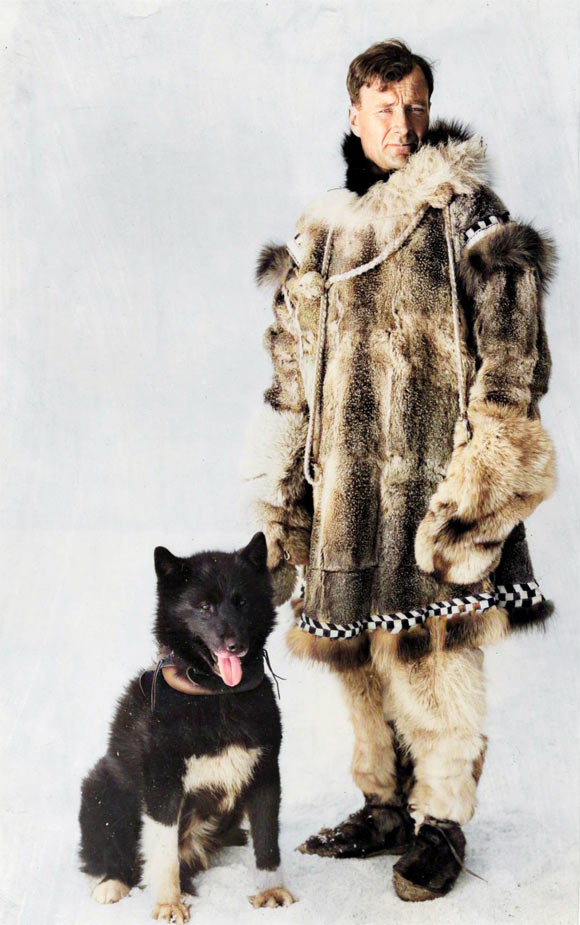The sled dog Balto has been celebrated in books and movies for his role in delivering desperately needed diphtheria antitoxin to Nome, Alaska, in 1925. He belonged to a population of small, fast, and fit sled dogs imported from Siberia. By sequencing his genome from his taxidermied remains and analyzing these data in the context of large comparative and canine datasets, scientists now show that Balto and his working sled dog contemporaries were more genetically diverse than modern breeds and may have carried variants that helped them survive the harsh conditions of 1920s Alaska.
It has been almost 100 years since Balto helped save the community of Nome, Alaska, from a diphtheria outbreak.
Today, Balto symbolizes the indomitable spirit of the sled dog.
He is immortalized in statue and film, and is physically preserved and on display at the Cleveland Museum of Natural History.
Balto represents a dog population that was reputed to tolerate harsh conditions at a time when northern communities were reliant on sled dogs.
Investigating Balto’s genome sequence using technologies for sequencing degraded DNA offers a new perspective on this historic population.
“Balto’s fame and the fact that he was taxidermied gave us this cool opportunity 100 years later to see what that population of sled dogs would have looked like genetically and to compare him to modern dogs,” said Dr. Katherine Moon, a postdoctoral researcher at the University of California Santa Cruz.
“I was enthralled growing up with sled dogs,” said Dr. Heather Huson, a researcher at Cornell University.
“They’re amazing athletes, they’re fast, but they have a lot of endurance. Mentally, they have to be tough.”
“What are the genes that make them an awesome sled dog? Why can they do these amazing things that your average dog can’t do?”
“While Balto was clearly a sled dog, his owner, Leonhard Seppala, was one of the founding breeders of the Siberian husky, raising the potential for some interesting overlap.”

Balto’s owner, Leonhard Seppala, posing with six of his sled dogs, from left to right: Togo, Karinsky, Jafet, Pete, unknown dog, Fritz, circa 1924-1925. Image credit: Carrie McLain Museum.
Dr. Moon, Dr. Huson and their colleagues were able to extract Balto’s ancient DNA — a difficult task, given how degraded and unstable the genetic material becomes over time — and they conducted the DNA sequencing and analysis.
They then compared the results with data, provided by the Zoonomia Project, of 240 mammal species and 682 genomes from dogs and wolves of the 21st century.
They found that Balto clusters most closely with Alaskan sled dogs, with a high genetic diversity and a lower burden of potentially damaging genetic variants.
He also had substantial ancestral similarity to Siberian huskies, Alaskan malamutes, Greenland sled dogs and outbred dogs from Asia.
“Siberians were kind of being created at the same time as the modern Alaskan sled dogs. This shows Balto is at the crux of that,” Dr. Huson said.
“He is showing that early foundation that’s actually similar between sled dogs and Siberians.”
“There is something to be learned from any dog — even unfamous ones — whose genetic diversity has changed over time.”
“It’s kind of funny, because for evolutionary geneticists, what I’m looking at is a drop in the bucket, the 1930s versus the 2000s, while they are looking at thousands to millions of years.”
“Yet, the domestication of most modern breeds has been in the last couple hundred years, so there’s been a huge selection intensity on dogs in that time.”
The study appears in the journal Science.
_____
Katherine L. Moon et al. 2023. Comparative genomics of Balto, a famous historic dog, captures lost diversity of 1920s sled dogs. Science 380 (6643); doi: 10.1126/science.abn5887








